The United States Metric Board (USMB)

On 23 December 1975, President Gerald R. Ford signed the Metric Conversion Act of 1975, which finally gave official federal sanction for the U.S. to convert to using the metric system.
Among other things, this 1975 law established the 17-member United States Metric Board (USMB) “to coordinate the voluntary conversion to the metric system.”
Although the USMB no longer exists — it was dissolved in 1982 — its history might be of interest. We’ll start by describing the intended membership and functions of the Board.
Contents
- USMB membership and function
- USMB beginnings
- USMB activities
- USMB disbanding
- President Ford’s USMB nominations
- President Carter’s USMB nominations
- USMB nominees confirmed
- First term expirations
- Other USMB personnel
USMB membership and function
The 17 members
USMB members were appointed by the President with the approval of the Senate. In addition to the Chairman (“a qualified individual”), there were 16 members chosen to represent various interests:
- one representing engineers;
- one representing scientists and technicians;
- one representing manufacturers;
- one representing retailers;
- two representing labor;
- one representing state and local governments;
- two representing small businesses;
- one representing the construction industry;
- one representing standards organizations;
- one representing educators; and
- four at-large members representing consumers and other interests.
The law went on to define the term lengths, etc.; for the details, see 15 USC 205d.
Functions and powers of the board
Although the board had no compulsory powers, the law did enumerate its functions. The one-sentence version:
“It shall be the function of the Board to devise and carry out a broad program of planning, coordination, and public education, consistent with other national policy and interests, with the aim of implementing the policy set forth in [the Metric Conversion Act of 1975].”
For the complete list of instructions to the Board for carrying out its functions, see 15 USC 205e.
USMB beginnings
On 1 August 1976, the Metric Information Office (MIO) of the National Bureau of Standards was shut down, its function to be assumed by the (presumably) soon-to-be-established USMB. The MIO employees were transferred to other positions within NBS.
In late September 1976, President Ford made the first set of nominations of USMB members, but the Senate didn’t act on the nominations prior to the end of Pres. Ford’s term.
On 27 October 1977, President Carter made his first set of nominations of USMB members, most of whom were confirmed by the Senate on 17 March 1978, so one might regard that as the date USMB finally began its existence.
USMB activities
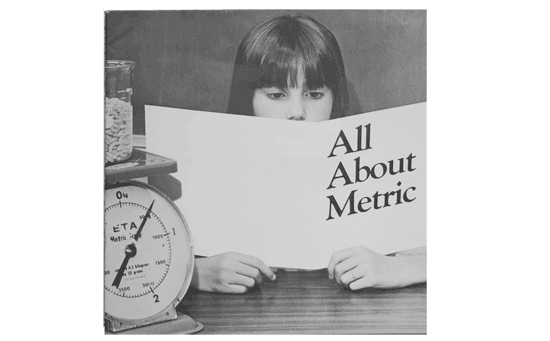
USMB published various educational materials including this 18-page booklet titled All About Metric, printed in 1982.
The USMB held public meetings every other month. Here are a few of the USMB’s activities.
USMB’s role
Ultimately, the USMB couldn’t decide what, exactly, its mission really was. For example, here’s a description of its 16–17 August 1979 meeting in San Francisco, from a the September-October 1979 U.S. Metric Association Newsletter:
The Thursday afternoon and Friday sessions consisted of strictly USMB business and included a discussion on interpreting the Metric Conversion Act of 1975, with some Board members feeling the Act does not charge USMB with encouraging metrication and that Congress did not intend for the U.S. to go metric when it passed that bill. Others cited paragraphs from the metric bill which state the USMB is to encourage development or revision of engineering standards on a metric measurement basis and the statement that the USMB is to coordinate “increasing use” of the metric system in the U.S.
At that meeting, the USMB passed the following resolution giving its somewhat vague definition of its role as well as its interpretation of the law (or, How many times can you use the word “voluntary” in a single paragraph?):
NATIONAL POLICY ON METRIC
In adopting the Metric Conversion Act of 1975, the Congress of the United States established a national policy of coordinating and planning the increasing use of the metric system in the United States. In so doing, the Congress committed the nation, in particular the United States Government, to taking steps to coordinate the increasing voluntary use of the metric system. Specifically, it created the United States Metric Board to coordinate the voluntary increased use of metric measurement. The key element of this national policy is its voluntary nature. Rather than occur by force of law, metrication is to proceed by the voluntary, coordinated decisions of each segment and sector of our society. There is no national mandate to convert to the metric system. U.S. law permits the use of either the metric system or the customary system.
ROLE OF THE UNITED STATES METRIC BOARD
The role of the Board is a simple one. It is to actively implement the national policy of voluntary metric conversion contained in Pub.L. 94-168 [the Metric Conversion Act of 1975]. In implementing this policy the Board is specifically directed to perform eleven tasks in Section Six of the Act. The voluntary program intended by Congress is aimed at ensuring changeover takes place in the most economic and effective way. Consequently, the Board must not become blind to metrication activity in the belief that all conversions are good. While the Board is to assist in the voluntary conversion process, it must remain objective. The Board should encourage all interested parties to participate in the planning process.
Gas pumps
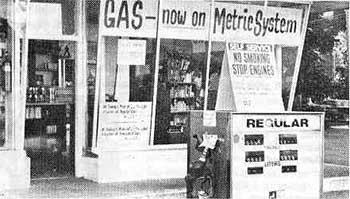
Gasoline by the liter in Minnesota, from the USMA Newsletter, Sep-Oct 1979.
At its 2–3 May 1979 public hearings in Washington, DC, the USMB considered the issue of gasoline pumps that were unable to handle prices higher than 99.9¢ per gallon. The 107-page report resulting from the hearings concluded that the U.S. would save at least $94 million by converting pumps to sell gas by the liter instead of converting the pumps to handle prices above $1 per gallon.
At its 21–22 June 1979 meeting in Boston, the USMB voted 13 to 1 to approve a resolution to support conversion of retail motor fuel pumps to dispense fuel by the liter:
RESOLUTION
The petroleum retailing industry generally indicates a willingness to dispense gasoline by the liter. Several states are taking independent action in requiring or recommending liter dispensing. Therefore, the United States Metric Board declares that:
This is an opportune time for the development of a planned and coordinated voluntary program of dispensing gasoline by the liter and the Board urges all affected parties to participate in the planning process. It calls atttention to the need for adequate public information in connection with liter dispensing.
Without taking this action, metric usage is likely to proceed in a haphazard fashion leading to public confusion, disparate end results and a negation of the positive cost advantages that a nationally planned and coordinated program offers.
PSAs
The USMB funded metric public service announcements. Some were TV PSA’s, as reported by the U.S. Metric Association Newsletter, March-April 1980:
[At the USMB public meeting in Phoenix on 14–15 February 1980,] a preview was made of a series of metric television spots by the March of Dimes, which was granted $8000 by the Board for their production and distribution. Many of the Board members were visibly embarrassed to hear “kilometer” repeatedly pronounced with the accent on the second syllable, because the TV spots have the endorsement of the U.S. Metric Board. The question remains how such a mistake could have passed without being detected.
The majority of the audience participants agreed that the Board should increase its public awareness and education program through public service announcements.
As of mid-1981, USMB had also produced 27 radio PSAs, aired under the title Metric Magazine. They were narrated by Johnny Holliday and provided a general outline of USMB activities, Board member views, and reasons for switching to SI, with comments from the public.
Perhaps it’s worth noting that there had been previous metric PSAs. In 1977 the U.S. Office of Education of the Department of Health, Education, and Welfare commissioned a series of PSAs. Taurus Productions of Colorado Springs produced a series of four, 60-second and four, 30-second TV PSAs as well as five, 60-second and five, 30-second radio PSAs featuring metric songs or jingles.
Metric Conversion Data Program
David Freund was Director of the Metric Conversion Data Program at USMB, which maintained a file of information on metrication from various sources including surveys, studies, and research projects by USMB and others, as well as news clippings, books, pamphlets, and the like.
This library was available for public use in USMB’s Arlington, VA, office, and USMB used it to reply to metrication questions from industry, government, the public, and the USMB itself.
USMB also provided a referral service. According to David Freund, “Perhaps only 5% to 10% of the services of the data program are physically located within the file drawers or bookshelves of the USMB. About 90% to 95% of the questions or requests for assistance from the Metric Conversion Data Program office are handled by referring the inquirer to an outside technical expert, an appropriate reference library, an industry trade official, or some other source of information that probably can supply the answer.”
Exports and imports
Questions about the impact of metrication on exports and imports frequently arose at USMB meetings, with one side arguing that metrication is good because the U.S. would be able to export more, and the other side arguing that metrication is bad because the U.S. would be able to import more.
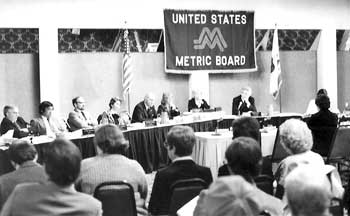
USMB meeting, San Diego, 1982-01-07.
Here’s an example, at the 7 January 1982 USMB meeting in San Diego, from the March-April 1982 USMA Newsletter coverage of the meeting:
Maureen Reagan, who heads a Woodland Hills-based export group, Sell Overseas America [and was a candidate in the California GOP Senate race], stated: “The biggest problem, now, is impressing upon American business, small and medium-sized companies, that there is a real profit potential in selling overseas.” She indicated support of U.S. metrication, noting, “American businesses are often penalized in the form of trade restrictions for not using the metric system. At any time a foreign country can and has required that we ship goods to them in metric measurements.”
She stated she supported federal legislation to provide incentives for metric conversion, noting that U.S. companies which do not use the metric system often have a problem exporting their goods when overseas countries invoke “capricious use of trade restrictions involving size and packaging.” She said that new restrictions may be imposed by foreign nations at any time, even when a shipment of goods is on its way. During the questions posed by USMB members, Union representative Tom Hannigan said that metric conversion would open the doors to all kinds of goods from overseas. GOP Senate candidate Reagan’s reply was: “Frankly, I don’t see how the problem of foreign imports into this country could get worse.”
Reviewing ANMC metric conversion plans
One of the USMB’s functions, according to the Metric Conversion Act of 1975, was to “publicize, in an appropriate manner, proposed programs and provide an opportunity for interested groups or individuals to submit comments on such programs. At the request of interested parties, the Board, in its discretion, may hold hearings with regard to such programs. Such comments and hearings may be considered by the Board.”
At least two committees of the American National Metric Council (ANMC) summitted metric conversion plans to the USMB for such treatment.
On 26 October 1981 the Chemical and Allied Product Sector (CAPS) Committee of the ANMC submitted its metric conversion plan, which proposed that shipping and billing of industrial chemicals be predominately metric by 1984, to the USMB. ANMC included the results of its survey of U.S. chemical companies, 72% of which agreed with the plan.
On the same date, the Instrument Sector Committee (ISC) of the ANMC submitted its metric conversion plan to the USMB. It called for voluntary conversion of instrument charts, scales, and mounting dimensions to metric, in response to the needs of instrument industry customers.
The USMB held public hearings on 17 December 1981, for the CAPS plan, and 18 December 1981, for the ISC plan, and then considered the results at its 7 January 1982 meeting in San Diego. The Board voted to approve the two plans, adopting the following two, nearly identical resolutions:
Having reviewed the ANMC Chemicals and Allied Products Sector Conversion Plan and finding the Plan to be in compliance with the Board’s Planning Guidelines, the Board endorses the Plan. This endorsement is not a mandate to proceed, since the USMB does not have such powers, but only a recognition by the USMB that the Plan has had adequate exposure, that affected individuals and groups have had an opportunity for comment, and that the USMB believes significant differences have been properly considered and resolved. The implementation of the Plan is now a matter for decision by individual companies, organizations and persons, but with the recognition that substantial coordination has been achieved.
and
Having reviewed the ANMC Instruments Sector Conversion Plan, and finding the Plan to be in compliance with the Board’s Planning Guidelines, the Board endorses the Plan. This endorsement is not a mandate to proceed, since the USMB does not have such powers, but only a recognition by the USMB that the Plan has had adequate exposure, that affected individuals and groups have had an opportunity for comment, and that the USMB believes significant differences have been properly considered and resolved. The implementation of the Plan is now a matter for decision by individual companies, organizations, and persons, but with the recognition that substantial coordination has been achieved.
[Ref. 46 FR 56768, 46 FR 56771, 47 FR 3439 × 2, USMA NL 1982 Mar-Apr p.8]
National Council on State Metrication
The USMB hosted at least two National Council on State Metrication (NCSM) meetings. The first was a three-day conference in Nashville on 23–25 September 1980, with representatives from 33 states. From the September-October 1980 USMA Newsletter:
The conference was organized by the Office of Research, Coordination, and Planning of the USMB, which is directed by Stanley Parent. Lawrence Chisholm, who is in charge of state activities, arranged details for the meeting. USMB members Sydney Andrews, Frank Hartman, and Thomas Hannigan each conducted separate sessions on different days discussing activities of the USMB and the progress of voluntary metric conversion in the U.S.
A series of four workshops was held in which metric problems related to education, planning, and state metric committees were discussed. Pamela Shintaku of California and George Mattimoe of Hawaii presented their respective states’ experiences with the conversion of motor fuel dispensing pumps to liters. Also discussed was the “Uniform Metric System Procedure Act,” a model law that thus far has not been adopted by any state.
Summarizing the second such meeting, in Des Moines, Iowa on 23–25 June 1981, the USMA Newsletter’s July-August 1981 issue reported:
Representatives from 35 states attended the three-day meeting; however, more would have come had it not been for the disruptions caused by the impending strike of air traffic controllers. According to John Gerhardt, chairman of the Colorado Metric Advisory Board, the Council was an informative, worthwhile experience.
Many of the state representatives expressed a sense of frustration with the lack of federal direction and leadership in metrication, and they felt that stronger metric legislation or guidelines by the Congress were needed to give the USMB more powers and accelerate the changeover.
The status of the sale of motor fuel by the liter was discussed by each representative. This change is moving ahead at a slower rate than originally expected, and there are examples of some stations changing from liters back to gallons, notably Standard Oil in California.
Metrication of laws and regulations
In 1979 the USMB submitted to Congress a 14-page report, “Providing a metric option,” in which it concluded that it’s not necessary to establish a new legal procedure for metrication of laws and regulations, saying most changes can be accommodated through administrative rulemaking rather than new legislation.
Surveying small businesses
In 1979 the USMB awarded a $65,000 contract to Damaus and Associates to conduct a nationwide survey to study how metrication would affect small businesses.
Distilled spirits
At its 5–6 November 1981 meeting in Denver, the USMB discussed a report it commissioned on the metric conversion of distilled spirits.
The report indicated that stronger guidance from government would have better served the public interest in converting liquor containers to metric sizes. It also found that the actual costs of conversion often are less than anticipated and that savings resulting from conversion normally continue from year to year.
USMB disbanding
Ultimately, the U.S. Metric Board did little to forward the transition to metric.
In the July-August 1980 USMA Newsletter, editor and President Emeritus Louis F. Sokol wrote:
On 19 June 1980, I had an opportunity to visit a meeting of the U.S. Metric Board. Prior to leaving for the Seattle meeting, I spoke with a business leader, a person of action who is a well-known metric promoter. When I told him I would attend my first USMB meeting, he said, “Louis, they’ll drive you up the wall.” Well, they did not exactly drive me up the wall, but much of what transpired represented an example of futility and frustration.
The diverse makeup of the Board and the weakness of the Metric Conversion Act contribute to the Board’s inability to exercise the type of leadership which knowledgeable, progressive people expect. The Board in action has all the outward appearances of a debating society. The blame for this to a great extent falls on President Carter, whose staff, for political reasons, appointed several known obstructionists and persons with little if any prior knowledge of metrication.
The USMB reminds me of a statement made recently by Dr. Patrick E. Haggerty, one of three engineers on the 12-member President’s Commission on the Nuclear Accident at Three-Mile Island. In response to a question concerning the makeup of the Three-Mile Island Commission, Dr. Haggerty stated: “It all depends. There is a stupid notion abroad in this society that the right way to do anything is to have every faction represented on its governing body. That’s not the way to run anything. A group that’s responsible for managing an activity must have as its responsibility the objectives of that activity. If you’re going to have, on boards of institutions, the anti’s, all the ones who are opposed to the purposes of the institutions, you’re going to end up with every decision being a compromise that assures its failure.”
In my estimation, the USMB would be more effective if all members supported metrication in the U.S.
From The United States and the Metric System, NIST LC 1136: “The efforts of the Metric Board were largely ignored by the American public, and, in 1981, the Board reported to Congress that it lacked the clear Congressional mandate necessary to bring about national conversion. Due to this apparent ineffectiveness, and in an effort [by President Reagan] to reduce Federal spending, the Metric Board was disestablished in the fall of 1982.”
As the March-April 1982 USMA Newsletter observes:
A rather perplexing statement appeared in the U.S. Federal Funding Appendix to the Budget for Fiscal Year 1983 document. On the page that listed the U.S. Metric Board budget, the column for USMB FY83 funds contained no figures. But the following statement accompanied the USMB listing:
The U.S. Metric Board is proposed for termination in 1983. The Board has accomplished its mission to familiarize the public with the metric system. Voluntary metrication will continue through market adjustments.
Frank Mankiewicz, president of National Public Radio in 1981, takes credit for encouraging Lyn Nofziger, President Reagan’s assistant for political affairs, to persuade President Reagan to dissolve the board. Writing in a 29 March 2006 article in The Washington Post, Mankiewicz says:
During that first year of Reagan’s presidency, I sent Lyn another copy of a column I had written a few years before, attacking and satirizing the attempt by some organized do-gooders to inflict the metric system on Americans, a view of mine Lyn had enthusiastically endorsed. So, in 1981, when I reminded him that a commission actually existed to further the adoption of the metric system and the damage we both felt this could wreak on our country, Lyn went to work with material provided by each of us. He was able, he told me, to prevail on the president to dissolve the commission and make sure that, at least in the Reagan presidency, there would be no further effort to sell metric.
It was a signal victory, but one which we recognized would have to be shared only between the two of us, lest public opinion once again began to head toward metrification.
President Ronald Reagan sent a letter to Louis Polk, Chairman of the USMB, on 9 March 1982, thanking him for his efforts. It was published in the USMB’s final summary report of July, 1982:
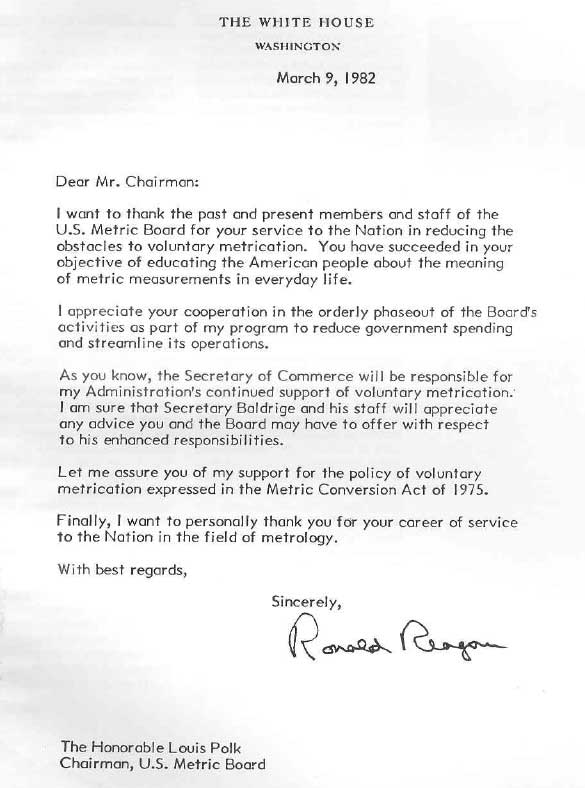
Another letter from President Reagan regarding the USMB shutdown, addressed to the ANMC:
THE WHITE HOUSE
WASHINGTON
April 6, 1982
I am pleased to greet members of the American National Metric Council at your Eighth Annual Conference.
As you know, my Administration proposes in the Fiscal Year 1983 Budget to Congress that the U.S. Metric Board be phased out as part of my program to reduce government spending, control inflation and bring down interest rates. At the same time, we also propose that, consistent with his responsibilities for measurement standards and for the promotion of U.S. exports, the Secretary of Commerce have lead responsibility for the continued support of voluntary metric conversion.
My Administration supports the policy of voluntary metrication expressed in the Metric Conversion Act of 1975. As the representative of the private sector in this area, your Council fulfills an important role in facilitating such conversion. I look forward to continued cooperation with your organization as we work together to make the United States more competitive in world markets.
You have my wishes for a productive and successful meeting.
Ronald Reagan
The summary report
Just before it dissolved — officially, on 30 September 1982 — the USMB issued the 44-page U.S. Metric Board Summary Report — July 1982, summarizing its four years of activities. A PDF copy of this report (8.6 MB) is available to USMA members as a membership benefit.
Among other things, it includes a list of findings and recommendations, with these main points (for the explanation of each, read the report):
Findings
- The present policy of maintaining a dual system of measures for trade and commerce is confusing to all segments of American society.
- Voluntary metric conversion by industry occurs primarily in response to marketplace demands and usually on a company-by-company basis.
- The costs of metric conversion have not been excessive.
- Large segments of industry have metric capability.
- Past perceptions of the difficulty of metric conversion have no basis.
- There are no substantial legal barriers to metric conversion requiring Federal preemptive action.
- There are no substantial technical problems with metric conversion.
- Consumers accept conversion according to their own interests.
Recommendations
- The Metric Conversion Act of 1975 should continue to be administered.
- National policy on metric conversion should be reassessed.
- Research should be conducted on economic sectors where metric capability may be critical.
- The Federal Interagency Committee on Metric Policy and the National Council on State Metrication should be continued.
- The functions outlined in the Board’s Private Sector Planning Guidelines should be continued.
- Government public awareness, consumer and education programs should be continued selectively.
- The States should consider enacting uniform metric conversion legislation.
The Summary Report also includes statements from each USMB member, providing their perspectives on metrication; a detailed summary of USMB activities; the metrication status of each federal agency; and a summary of each state’s metric conversion status.
It also includes a brief summary of USMB expenditures and a bibliography of USMB publications.
OPTI
The functions of the USMB were transferred to the Office of Productivity, Technology, and Innovation (OPTI) in the Department of Commerce. On 10 February 1982, Egils Milbergs, Director of the OPTI, made a statement to the House Subcommittee on Science, Research, and Technology:
Because the voluntary conversion process is critical to the ability of U.S. products to compete in world markets where the metric system is the accepted standard, those functions of the Board which cannot be performed by non-governmental entities should continue to be performed by the Federal Government.
OPTI’s functions and activities would include:
- Responding to inquiries from business and the public concerning conversion procedures and data.
- Identifying and alleviating existing barriers to voluntary conversion.
- Acting as liaison between the Federal Government, private industry, and non-Federal organizations to facilitate progress.
- Serving as a watchdog for U.S. business interests unfairly treated in foreign markets because of metric use as a non-tariff barrier.
- Acting as an intra-Governmental coordinator to prevent conflicting Federal agency policies on metrication.
The metrication arm of OPTI was originally to be named the Office of Voluntary Metric Conversion, but it ended up as the Office of Metric Programs (OMP) and initially had a staff of five and a budget of $300,000 a year. Dr. David Goldman of the NBS was named Acting Director pending selection of a permanent director.
NIST
Ultimately, the metrication functions were transferred to the National Institute of Standards and Technology (NIST), another branch of the U.S. Department of Commerce. Today the metrication functions are handled by the Metric Program in the Laws and Metric Group of NIST’s Weights and Measures Division.
USMA’s president attended many meetings of the Metric Program office and worked closely with its personnel, and continues to coordinate with them.
President Ford’s USMB nominations
The following sections describe the USMB appointment timeline and lists the nominees.
In late September 1976, President Ford nominated the first set of appointees to the U.S. Metric Board. Unfortunately, the U.S. Senate never got around to approving the nominations before President Ford’s term expired, so the appointments were never made, but following is a list of President Ford’s nominations, showing the name, sector represented by that nominee, and the nominee’s position.
USMB members would serve a six-year term on a staggered schedule, with roughly one-third of the members’ terms expiring every other year. Thus, the initial members’ terms would be two, four, or six years, as indicated below. (Members could be reappointed when their terms expired, but note that the USMB lasted only four years.)
| For 6-year terms | |||
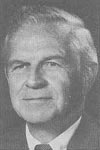 |
Dr. Louis F. Polk | Chairman | Chairman, State Fidelity Savings Association, Dayton, OH |
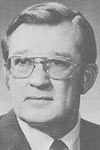 |
Francis R. Dugan | Construction | President, Dugan and Meyers Construction Company, Inc., Cincinnati, OH |
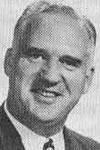 |
Frank Hartman | Education | Liaison representative, Michigan State Department of Education, Lansing, MI |
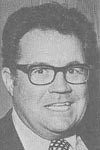 |
James D. McKevitt | Small business | Attorney, National Federation of Independent Business, Alexandria, VA |
 |
Jerry J. McReal | At-large | President, Media Research Associates, Salem, OR |
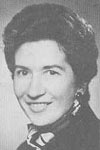 |
Mrs. Satenig S. St. Marie | Commercial | Divisional VP and Director of Consumer Affairs, J. C. Penney Company, Inc., NY |
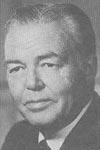 |
Kenyon Y. Taylor | At-large | Chairman and CEO, Regal-Beloit Corporation, South Beloit, IL |
| For 4-year terms | |||
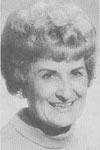 |
Valerie Antoine | Engineering | Data manager, Litton Data Systems, Van Nuys, CA; VP, USMA |
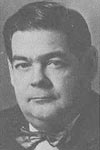 |
Carl A. Beck | Small business | President, Charles Beck Machine Corporation, King of Prussia, PA |
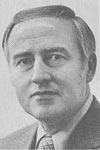 |
Ralph V. Durham, Sr. | Labor | Director, Safety and Health Dept., International Brotherhood of Teamsters; President, Teamsters Local 391, Greensboro, NC |
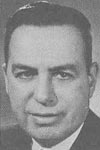 |
W. E. Hamilton | At-large | Chief economist, American Farm Bureau Federation, Wheaton, IL |
 |
Harry Kinney | State and local government | Mayor, Albuquerque, NM |
| For 2-year terms | |||
 |
Harold M. Agnew | Scientists | Director, Los Alamos Scientific Laboratory, Los Alamos, NM |
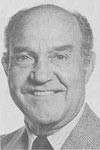 |
Sydney D. Andrews | Standards | Director, Division of Standards, Florida Department of Agriculture and Consumer Services, Tallahassee, FL |
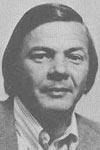 |
Andrew H. Kenopensky | Labor | National automotive coordinator, International Association of Machinists and Aerospace Workers, Union, NJ |
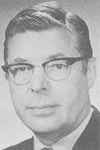 |
Adrian G. Weaver | Manufacturing | Director, Standards Practices, IBM Corporation; first Chairman, American National Metric Council, Armonk, NY |
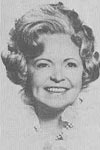 |
Virginia H. Knauer | At-large | Special assistant to the President for Consumer Affairs; Director, Office of Consumer Affairs, Department of Health, Education, and Welfare, Washington, DC |
President Carter’s USMB nominations
On 27 October 1977, the Presidential Personnel Office of the White House officially announced President Jimmy Carter’s list of nominees to the U.S. Metric Board. The list was published in the 28 October 1977 issue of the Congressional Recordand consists of 15 persons instead of 17: The list included no nominee to represent educators and only one nominee to represent labor. Following is the list of nominees by sector.
(These writeups were published in the November 1977 USMA Newsletter, so present-tense in the biographical entries refers to that time frame. Here the sectors are listed in the order they appear in the law, as in the list above. Notations like “6 years” are explained in the next section.)
Chairman
Dr. Louis F. Polk, Dayton, OH, is a metrology expert and a retired vice president of the Bendix Corporation. He presently serves on the executive committee of the Fidelity Federal Savings of Dayton. He was chairman of the U.S. Department of Commerce’s Metric Study from 1968 to 1971. Dr. Polk has been active in activities of the American National Standards Institute (ANSI) and is a former ANMC director. (6 years.)
Engineers
Dr. Henry Kroeze, Brookfield, WI, is chairman of the Department of Engineering and Computer Science at the University of Wisconsin-Waukesha. He is a member of the Engineers Joint Council Metric Commission, the ANMC, and the USMA. Dr. Kroeze is a native of the Netherlands and a long-time promoter of metrication on the local and national levels. (2 years.)
Scientists and technicians
Dr. Edward Ginzton, Palo Alto, CA, is chairman of the Board of Varian Associates, a company engaged in research and development in the microwave electronics field. He had been a professor of electrical engineering at Stanford University.
Manufacturers
Adrian G. Weaver, Armonk, NY, is director of product safety for the IBM Corporation, and is an expert in engineering standards. He is past chairman of the Board of Directors of the ANMC and is presently a board member and on its executive committee. (6 years.)
Retailers
Dr. Satenig St. Marie, New York City, is a divisional vice president and director of consumer affairs for the J. C. Penney Company. She is a past president of the American Home Economics Association and a member of the ANMC consumer liaison committee. (6 years.)
Labor
Thomas A. Hannigan, Washington, DC, is assistant to the International Secretary of the International Brotherhood of Electrical Workers (IBEW). He served on the U.S. Metric Study 1968 to 1971. Mr. Hannigan is a member of the ANMC board of directors and its executive committee. He has a long record of opposition to national metrication dating back to 1970. (4 years.)
No nomination. (There are two positions for representatives of labor on the USMB.)
State and local governments
Dr. Frank Hartman, Lansing, MI, is a federal liaison representative for the Michigan State Department of Education in Washington. He has been a high school teacher, principal, and superintendent of two school districts. (4 years.)
Small businesses
Carl Beck, King of Prussia, PA, is president of the Charles Beck Machine Corporation, which manufactures machinery for the packaging and converting industries. He is active in the affairs of the National Small Business Association. Mr. Beck is a member of the ANMC board of directors and its executive committee. (2 years.)
Roger Travis, Holbrook, MA, is president of Medi Inc, a manufacturer of disposable medical products. He is also president of the Smaller Business Association of New England. (4 years.)
Construction
Francis R. Dugan, Cincinnati, OH, is president of the Dugan & Meyers Construction Company. He has held official positions at local and national levels with the Associated General Contractors of America including membership on its metric committee. (2 years.)
Standards
Sydney D. Andrews, Tallahassee, FL, is director of the division of standards of the Florida Department of Agriculture. His is a past chairman of the National Conference on Weights and Measures and is chairman of the Florida Metric Council. Mr. Andrews is chairman of the ANMC Weights and Measures Sector Committee and also a member of the U.S. Metric Association. He has been actively promoting metrication for many years. (6 years.)
Educators
No nomination
Members-at-large
Dr. Paul Block Jr. is publisher of the Toledo Blade. He has been a professor of chemistry at the University of Toledo since 1950.
Sandra R. Kenney, Owings Mills, MD, is continuity director fot the Maryland Center for Public Broadcasting. She has taught art in Ohio and Baltimore and has been associated with instructional television since 1970. (4 years.)
Joyce D. Miller, New York City, is a vice president and director of social services for the Amalgamated Clothing and Textile Workers Union. Ms Miller is national president of the Coalition of Labor Union Women and serves on the AFL-CIO standing committee on civil rights. (6 years.)
Glenn Nishimura, Little Rock, AR, is executive director of Arkansas Consumer Research, and he is vice president of the Consumer Federation of America. (6 years.)
USMB nominees confirmed
On 17 March 1978, the Subcommittee on Science, Technology, and Space of the Senate Committee on Commerce, Science, and Transporation held public hearings led by Senator Edward Zorinsky of Nebraska.
Thirteen of the nominees were present and confirmed as USMB members — all of the individuals listed above except Dr. Paul Block, Jr., who was absent due to a prior commitment, and Dr. Edward Ginzton, who withdrew his name — for the terms indicated by the “n years” notations shown above.
In addition, the two “missing” nominees were named, but too recently to appear at the hearings. Andrew H. Kenopensky, the national automotive coordinator of the International Association of Machinists and Aerospace Workers in Union, NJ — one of the original, 1976 nominees — was nominated as the second labor representative, and Dennis R. Smith was nominated to represent educators, but no science representative was nominated to replace Dr. Edward Ginzton.
On 12 June 1978, public hearings were held to confirm the remaining USMB nominees, including a science representative: Dr. Bruce P. Johnson (science, 2-year term), plus Dr. Paul Block (at-large, 4-year term), Andrew H. Kenopensky (labor, 6 years), and Dennis R. Smith (education, 2 years).
First term expirations
The two-year terms of Carl Beck (small business), Francis Dugan (construction), Henry Kroeze (engineering), Dennis Smith (education), and Bruce Johnson (science) expired in 1980. In addition, Paul Block, an at-large member, resigned in 1980.
President Carter renominated Francis Dugan and Dennis Smith to their respective positions, and Bruce Johnson to replace Paul Block as an at-large member. He also nominated Marcus B. Crotts of Winston-Salem, NC, to represent engineering, replacing Henry Kroeze; Alfred Cantu of Cantu Advertising & Graphics in Denver to represent small business, and Dr. James Rosser, President of California State University, Los Angeles to represent science, replacing Bruce Johnson.
Other USMB personnel
This is not a complete list of USMB personnel, but here is some information on others at the USMB.
At the USMB’s second meeting on 10 May 1978, Malcolm O’Hagan was hired as executive director. Dr. O’Hagan was formerly president of the American National Metric Council (ANMC) in Washington. He was selected from a list of nine candidates and assumed his official duties to the $52 300-a-year post on 1 July 1978. The USMB office was at 1815 N. Lynn St, Room 301, Arlington, VA 22209.
By early 1979, USMB had appointed
- Stanley Reed Parent, Director for Research, Coordination, and Planning and Deputy Executive Director
- Theodore S. Farfaglia, General Counsel
- John Donnelly, Director of the Office of Public Information
- Alban Landry, Acting Director, Office of Administrative Services and Finance
The April 1979 USMA Newsletter included this organizational chart:
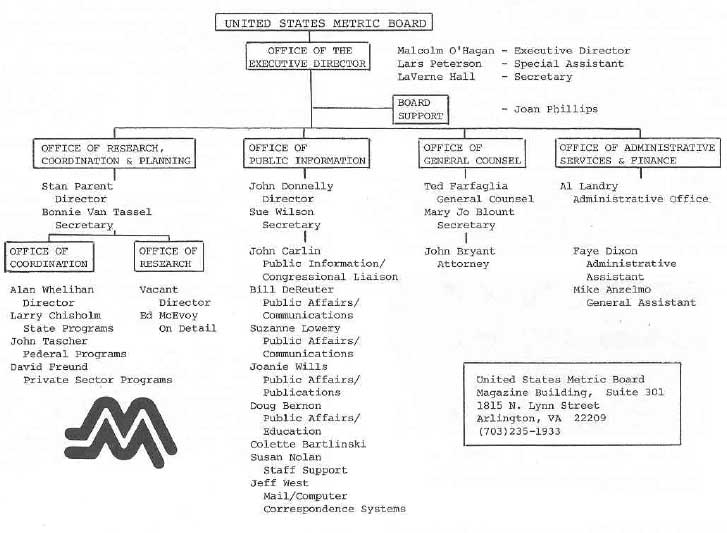
In 1980, USMB hired
- James G. Cast, Audio-Visual Specialist
- Dan Hoagland, Research Analyst, Office of Research
- Dan Peyser, Deputy General Counsel [note: another source gives his name as Stanley Peyser]
- Gene Visco, Research Analyst, Office of Research
At the 10 July 1981 meeting in Charlotte, NC, Theodore S. Farfaglia was named Executive Director of the USMB, succeeding Dr. Malcolm O’Hagan, who had resigned at the end of May 1981 to serve as President of the Valve Manufacturers Association.
Farfaglia joined USMB in November 1978 as general counsel and previously had served as minority counsel, Intergovernmental Relations Subcommittee of the Senate Government Affairs Committee for Senator Willliam V. Roth Jr. From 1963 to 1973, he served as a judge advocate on active duty with the U.S. Air Force.
Stanley Peyser replaced Farfaglia as general counsel [note: another source gives his name as Dan Peyser].
Back to USMA home.
Copyright © 2005–2013, US Metric Association (USMA), Inc. All rights reserved.
This page prepared by USMA member Gary Brown.
Updated: 2013-06-11